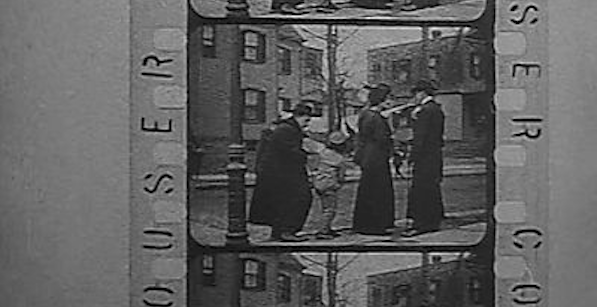So much of film history—with its ubiquitous references to such early cinema pioneers as Georges Méliès, Cecil Hepworth and R.W. Paul—hinges on the cinephile’s unspoken agreement that those works of art have already reached their apex. More specifically, that it would be sacrilegious if one were to do anything else with them, aside from physically preserving those reels of film for archival purposes. Even though iconic imagery reappears in the postmodern pop culture (e.g. the moon with a rocket in its eye from A Trip to the Moon), the images and films are mostly repurposed in an effort to keep intact those films’ original structure or motif. In Hugo, for example, director Martin Scorsese went to great lengths disguising his “Méliès Film 101 Lesson” as a commercial family film. Unfortunately, there was no room for prodding at the Méliès discourse (e.g. the amount of physical body action that occurs inside of Méliès’ full-frame photography) during Hugo’s bloated running time—which is a shame because if there were ever filmmaker with the power to do so, it’s Martin Scorsese. Like the Bible, early cinema is treated like a holy relic that can only be taught and shared but never challenged or, dare we say, altered.
And yet, here we are.
Today’s digital cinematic discourse invites more appropriation art than any of the preceding film movements. Because of free online distribution tools, streamlined editing platforms and an insatiable appetite for discovery, more filmmakers continue to push the envelope on the video essay (or “video mashup”) form.
I recently came across a burner of a selection called The Evidence of the Film from 1913, the heyday of early cinema. The storyline, in so few words, follows a female film editor who proves the innocence of her younger brother (a courier) by exhibiting a reel of film to court officials. Intrigued by the idea of an early film entry that used the act of filmmaking as a plot churning mechanism, I began reshaping Evidence into an elliptical, fluid narrative that encompassed other touchstones of early cinema, including alternate versions of the Lumière brothers’ Arrival of a Train and Exiting the Factory. What began to emerge during the editing process was a strange, lucid and much darker narrative about “moviemaking” clips having a direct effect on each other. Look closely at Alice Guy Films a “Phonoscene” and watch how Charlie Chaplin, dressed as a woman, rises from the group of Alice Guy’s stage models, only to wander and interrupt a camera man on the street from A Busy Day. This altercation eventually bleeds back into a moment from another Guy film: At the Photographer’s.
More exciting is how a contemporary film like Arriving/Departing seamlessly fit into this newly imagined narrative. It’s not so much that it’s also shot in black and white; it falls into place because shares some of the other films’ unabashed submission to simply being experienced—and not just explained.
Perhaps what’s most telling from this exercise is how much art (in this case, the medium of film) is influenced by what came before. In my video essay, it’s a literal relationship, as one clip speaks to the next; in historical context, the images we see on the screen, as original as they may seem, stem from something those filmmakers previously saw, whether in a painting, photograph or other motion picture. Because film is so young (it’s barely over a century old) we have yet to recognize the opportunity for what great heights appropriation art in cinema can achieve. It can introduce forgotten moving images to new audiences. It can also offer the opportunity to challenge, the opportunity for reimagining, the opportunity to perceive the human experience in a whole new light.
Video: Evidence of an Elliptical Film
Another century from now, cinephiles will be looking at all the video essay films coming from the early 2000s (just as we look at the early cinema of the 1900s) and they’ll ponder over its cultural significance; they might even spend their efforts preserving our new works. Yet, if we’re really lucky, they’ll want to spur a historical dialogue, by reshaping our voices into something that best describes what they’re feeling, what they’re seeing. Now that would be the apex of the cinematic form.
Nelson Carvajal is an independent digital filmmaker, writer and content creator. His video essays on cinema have been published on indieWIRE’s Press Play and Fandor’s Keyframe. Carvajal’s video art pieces and experimental short films have screened at the London Underground Film Festival, the 0110 International Digital Film Festival and the Oregon Independent Film Festival. You can follow him on Twitter.




